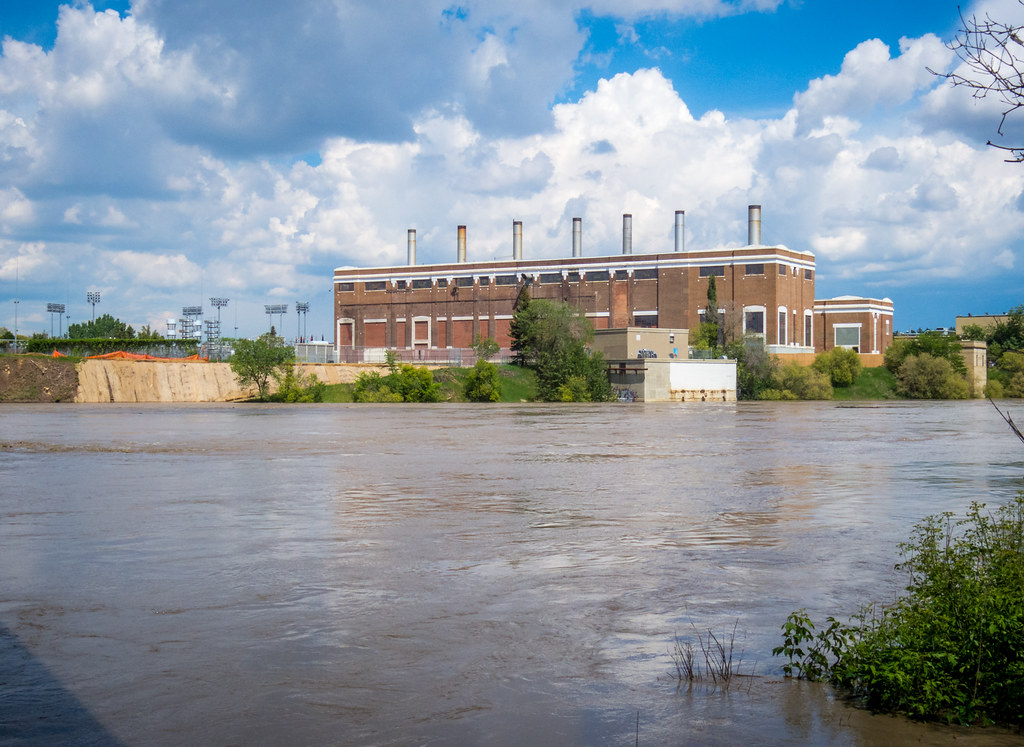In much of Alberta, climate change threatens to make water a scarce resource. But for Edmonton's water supply, the main concerns will come from having too much rather than not enough.
Temperatures and precipitation levels in the Edmonton region are expected to rise because of climate change. The North Saskatchewan River is already seeing increased seasonal fluctuations, and the heightened likelihood of major storms and flooding could affect the security of the city's water treatment plants, both of which are located in a flood plain.
EPCOR's Source Water Protection Plan states that a one-in-100-year flood has the potential to cause significant damage to both the Rossdale and E.L. Smith water treatment plants. Less severe storms, like the 1986 flood that turned city streets into canals, can also cause short-term disruptions.
To protect against these unpredictable events, EPCOR is working to install flood barriers to shield the treatment facilities and move critical infrastructure out of the flood plain.
"In terms of potable water supply, or drinking water supply, there is a flood hardening project that we're doing at both the water treatment plants to create barriers around the plants to protect in times of a one-in-500-year flood, plus a contingency for some greater variability from climate change," said Steph Neufeld, a watershed manager with EPCOR.
Some of this work, such as the relocation of infrastructure to less vulnerable locations, is already underway. Findings from consultations on the flood barriers will be presented to city council in 2023, and EPCOR expects to begin construction in 2024.
The security of Edmonton's water treatment plants affects not just city residents, but the many surrounding communities that are supplied from these same reservoirs. Because there are 28,000 square kilometres of the North Saskatchewan upstream of the Rossdale water treatment plant, researching the impacts of climate change on the river involves several stakeholders between Edmonton and the headwater.

EPCOR plans to install flood barriers and move critical infrastructure to secure water treatment plants against future serious weather events. (Kurayba/Flickr)
"Understanding climate change impacts on the river is essentially a whole basin issue," Neufeld said. "It's a collaborative effort with our partners – City of Edmonton, Alberta Environment and Parks, upstream municipalities, the North Saskatchewan Watershed Alliance – to really understand not just climate change, but general watershed science. To support monitoring programs, research programs, and modelling that is going to allow us to make evidence-based decisions on water supply and water quality."
Melting glaciers will bring water shortages for one in four Albertans. As the North Saskatchewan River is less than 2% glacier-fed, it doesn't share the same risk of diminishing supply. Expectations are that increased rain will increase the volume of the river and cause greater seasonal fluctuations, which can have an effect on water quality.
"Often, we would see higher sediment movement, higher precipitation can mean more organics moving into the watershed, and those sorts of things," Neufeld said.
Existing infrastructure will be able to handle this increased turbidity in the river, Neufeld said, adding that the watershed is already a variable system their work must adapt to. A bigger concern for the city's water treatment plants comes from the risk of floods and extreme weather, something existing climate models are less accurate in anticipating.
"Those severe weather events and stuff are at a much smaller scale over one day, or over four hours. And currently, those models are unable to predict those sorts of severe events or the increases in the severe events," Neufeld explained.
One researcher from Western University has found that these types of significant events are happening with greater frequency, and anticipates that up to 30% more of Canada could be underwater by 2100.
Although these possibilities are alarming, the watershed is already a highly variable system, Neufeld asserted, and those who work with it are accustomed to adapting to its changes.
"I wouldn't say that we're really expecting challenges or issues, I think we're expecting change. And that's what climate change means."
This story is part of Taproot's participation in Covering Climate Now's joint coverage week, running from June 27 to July 1. Find more #CCNow coverage from around the world.
